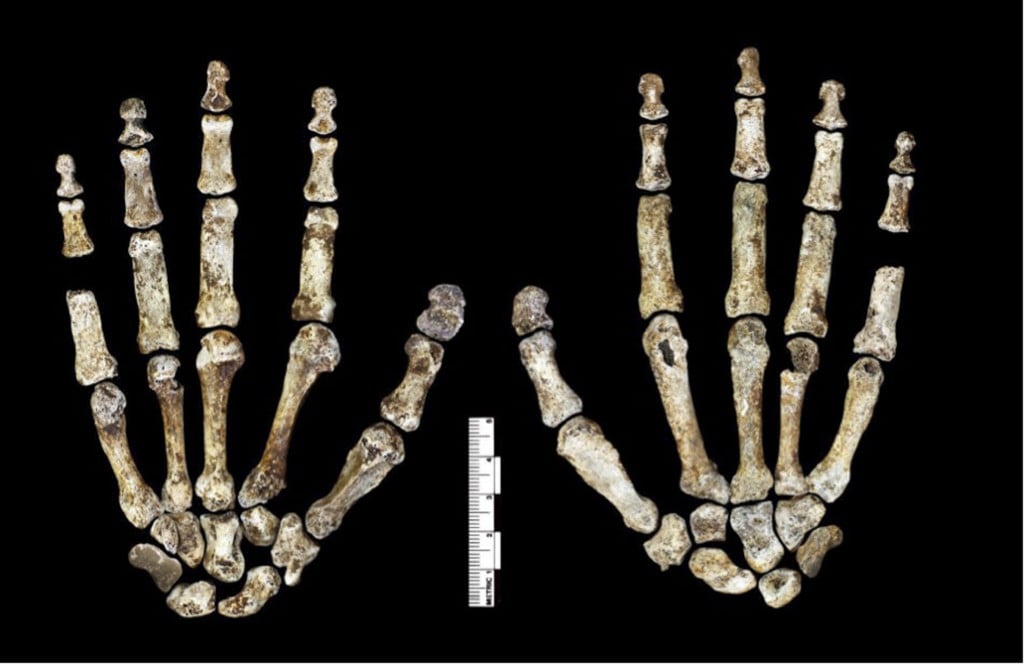On September 10th, 2015, the University of Witwatersrand, the National Geographic Society, the Department of Science and the National Research Foundation of South Africa announced the discovery of a new species of human relative, Homo naledi. With more than 1,500 numbered fossil elements, this discovery is the largest fossil hominin find ever made on the continent of Africa. Not only does this finding shed light on the origins and diversity of our genus, but it appears that this new species intentionally deposited the bodies of its dead in a remote cave, an action previously conceived limited to humans.
https://commons.wikimedia.org/wiki/File:Homo_naledi_hand.jpg
The species was initially discovered in 2013 in a cave known as Rising Star in the Cradle of Humankind World Heritage Site, some 50 km northwest of Johannesburg, South Africa. The fossils were laid in a chamber about 90 meters from the cave’s entrance, which was accessible only through a narrow chute which required a special team of very skinny individuals to retrieve them. Up and till now the team has recovered parts of at least 15 individuals of the same species. Lee Berger, research professor at Wits University and leader of the expeditions that recovered the fossils said, “With almost every bone in the body represented multiple times, Homo naledi is already practically the best-known fossil member of our lineage.”
Homo naledi has surprisingly human-like features, enough to place it in the genus Homo. It has a tiny brain, about the size of an orange (about 500 cubic centimeters), on top of a very slender body. The research shows that on average H. naledi stood approximately 1.5 meters (about 5 feet) tall and weighed about 45 kilograms (almost 100 pounds). Homo naledi‘s teeth are described as similar to those of the earliest-known members of our genus, such as Homo habilis, as are most features of the skull. The shoulders, however, are more similar to those of apes. The hands also suggest tool-using capabilities. It has extremely curved fingers, more curved than almost any other species of early hominin, which clearly demonstrates possible climbing capabilities.
The most remarkable part of the find is that it has led the researchers to conclude that this primitive-looking hominin may have practiced a form of behavior previously thought to be unique to humanism, intentional body disposal. The space in which the fossils were discovered was so remote that out of more than 1,550 fossil elements recovered, only about a dozen are not hominin, and the few that were not are isolated mouse and bird remains, meaning that the chamber attracted few accidental visitors.
The researchers explored every alternative scenario, including mass death, an unknown carnivore, water transport from another location, or accidental death in a death trap. After examining every other option, they were left to accept intentional body disposal by Homo naledi as the most plausible scenario.
There is still much to be discovered in the Rising Star cave. “This chamber has not given up all of its secrets.” There are potentially hundreds if not thousands of remains of Homo naledi still down there waiting to get uncovered.
Original Article: http://www.biologynews.net/archives/2015/09/10/new_species_of_human_relative_discovered_in_sa_cave.html
For more information, check out: http://news.nationalgeographic.com/2015/09/150910-human-evolution-change/



jackuole
Great article Biodeversity! Did you know that the existence of the Homo Naledi is a hotly debated topic in the world of Anthropology and Paleoanthropology? Berger published his claims in just two years, which brought skepticism about the thoroughness of his findings from other scientists. Anthropologist Tim White believes the fossils found in South Africa to be from the already well known genus of Homo Erectus. This debate over the validity of Berger’s finds will uphold the truth of the final verdict that is reached, a good outcome.
Source:
http://gizmodo.com/the-controversy-over-homo-naledi-is-actually-a-good-thi-1738572110